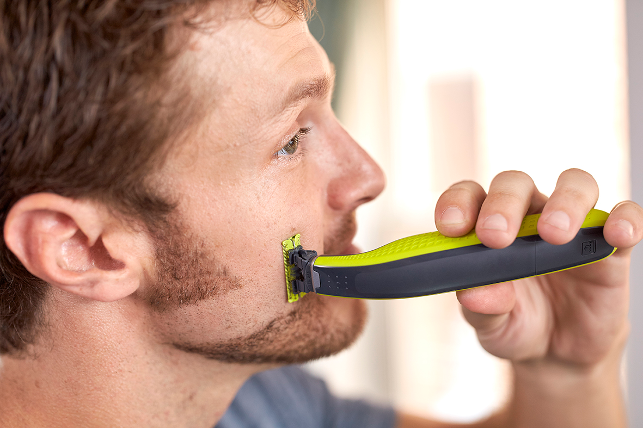
The OneBlade has a waterproof handle for wet or dry use
An interesting fact about male grooming is that it only became fashionable to be clean-shaven after the First World War. Soldiers in the US army were required to have a smooth face so that their gas masks would fit properly, and were issued with new Gillette razors for this purpose.
When they returned home after the war, the trend caught on and many a young man was taking a razor to his face to achieve that much coveted baby soft skin.
This is very different to today where stubble is socially acceptable and young men don’t feel the pressure or the need to shave every day. If anything, they only shave a few times a week or not at all if they’re cultivating a hipster inspired beard.
In fact, according to a Unity Global Study in 2014, men shave fewer than three times per week and only 9 per cent of men aged 18-24 shave every day.
Philips, which has many products within the male grooming category, noticed this trend too from its own sales. Although its beard trimming business was growing, it was selling less electric shavers.
As a result, in 2012 it started carrying out some internal research and working with focus groups in co-create sessions. “The male grooming category was due a disruption and we discovered that young guys hardly seem to want to use the same tools as their fathers did,” says Jens Andersson, design lead, male grooming at Philips.
“They’re not interested in electric shavers and instead opt for manual blades. This was an opportunity to design a product that would appeal to them.”
Multiple tools
They discovered that, although young men are shaving less, they’re actually changing styles more.
They may grow stubble on the weekend or indeed for a week before they shave. For this they were using multiple tools because a beard trimmer wouldn’t give a clean shave and a manual blade wouldn’t get through a week’s worth of beard.
So Andersson and his team set about exploring the possibility of a dual sided blade hybrid tool that was somewhere between an electric shaver and a manual blade. In these early stages they were exploring with sketches before moving into CAD, the main tool being SolidThinking Evolve, and using that data to produce basic prototypes.
Some of these prototypes then went back to the focus groups to gauge feedback. “We really try to connect as often as we can with users in the early stage of product development to really learn a lot in the beginning so that we de-risk our development process when we start to invest more and more,” says Andersson.
In the meantime, in Philips’ innovation lab, the engineers had been working on a new linear cutting technology. Being a technology driven company, it needs to constantly explore new technologies and innovation to remain a leader in its field.
What they had developed was a single blade with a cutting mechanism that can move 200 times per second to achieve a close shave but not quite ‘baby smooth’.
Philips didn’t yet know how to position this new technology within its male grooming portfolio and did some work with users in different parts of the world to discover how they could bring it to the consumer in a meaningful way. The ‘eureka’ moment came when they thought of bringing this technology to the clean-shaving averse young man.
Having found their niche, the engineers took this new cutting element and fashioned it onto an existing handle to see if it could do the job. It could but it needed the head to pivot to help tackle the more difficult areas of the face.
“While at first it cut from one side of the cutter, we made it cut from both. So you can go back and forth and it will also follow the contours of your face to cut as close as possible,” describes Andersson.


To appeal to the younger man, the designers explored various concepts through sketches. They were particularly keen to bring contrast into the product through the use of colour
Breakthrough technology
Now, with a blade technology that could shave, trim as well as edge, the challenge was to create a product that could communicate that to users.
The aim was for it to look like nothing else on the market – reminiscent of an electric shaver but with something exciting injected into it.
“When launching a new technology it’s very difficult to communicate what it is or does. And typically with shavers you don’t have a lot of time to explain – people just look at the product and draw their own first conclusions,” explains Arjen Benders, Philips’ design director.
With the challenge set to develop a product that would appeal particularly to younger men, the design team drew inspiration from various mood boards that they had put together. “It’s more about fashion trainers and headphones than luxury cars and expensive watches,” says Andersson.
They also wanted to bring contrast into the product. This would be achieved through contrasting colours but also grip patterns on the handle that could help convey that, like a manual blade, this product could be used in the shower.
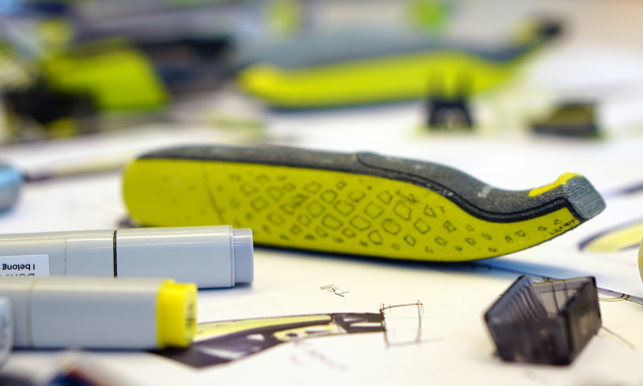
Here the grip pattern on the product’s handle is being explored. This will help convey that it’s suitable for use in the shower
Design cues
Another design cue that they took from manual blades was to emphasise the eject function with a large button, which will release the blade when it needs replacing (about every four months).
“We thought that this would help emphasise the fact that this product is something different from a traditional electric shaver because it has a replaceable element or a consumable,” says Andersson.
With sketches developing on the design side, the engineering team meanwhile were working on the technology components and electronics in SolidThinking, which would then be passed over to the designers.
According to Andersson, many CAD models were built to explore the various expressions of the product and consequences of different choices. As is often the case in most development projects, there is an element of give and take between engineers and designers.
“Certain engineering solutions might lead to a size increase, for instance, and then this would need to be visualised with a model really quickly. Equally, design may push it too far and the engineers can’t make it. There’s a lot of back and forth but we tried to keep a constant flow of updated models so that there is always the latest volume model at hand in the studio,” comments Andersson.
One key element that they worked particularly hard to achieve with the engineering team was a thinner handle than that of a traditional electric shaver so as to increase visibility around the cutting element.
“For blade users who are, for instance, creating edges to maintain a certain style, they don’t want to have half their face covered by a big, chunky product. They want visibility to be able to see what you’re doing and a product that is as thin as a blade is more appealing,” explains Andersson.
To test their various concepts, the CAD data is used to produce prototypes and in the early stages these are just basic volume models. These are then used internally to judge the look, size and ergonomics and are also brought to weekly meetings with the marketing team, which take place throughout the development process, for their input and feedback.
At regular intervals, they will also check in with users to see whether they are on the right track. If changes need to be made, the design and engineering team will refine the CAD model and then more prototypes will be produced.
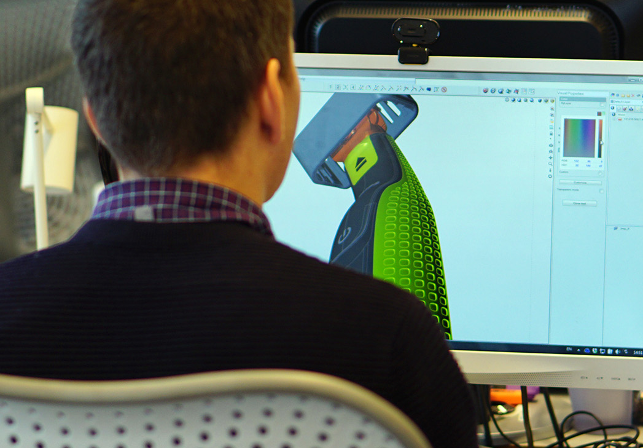
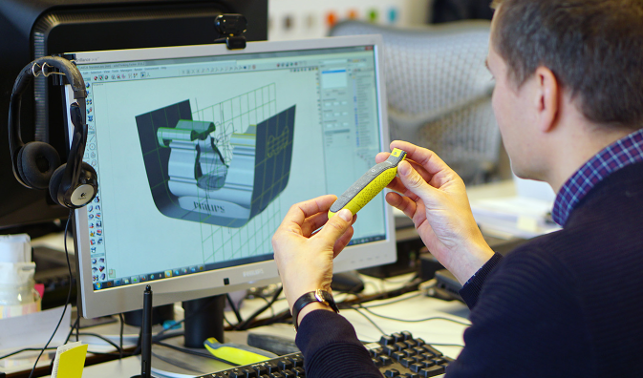
Jens Andersson, design lead, male grooming at Philips, working on models of OneBlade in SolidThinking Evolve
This is an ongoing cycle with many loops. As Andersson says, “It is always a moving target in a product development like this – so we constantly need to shift direction a little bit with the different input we get.”
Further into the development process as the design becomes more refined, more sophisticated prototypes are made. These are done at the model shop within Philips’ development site, which is an hour and a half drive from the design office in the Amsterdam headquarters, and contains a number of 3D printing machines and processes. Often, a CAD file is sent to a machine and a 3D print is couriered the next day or the day after.
One 3D printing tool that the team found very beneficial was the 3D Systems ProJet 600 colour printer. “You just define the colour you want in CAD and then the printer prints like an inkjet printer but in 3D. It’s really helpful because you get an impression of where the split lines are and the contrasts in the product. That definitely helps a lot,” says Andersson.
Benders adds, “Most of the time we want products to appear smaller than they are because technology is bigger than what we would like. Having colour breaks up the volume to make the product appear smaller and now we can already see this effect in the 3D prints. And also, we can experiment with different colours to try make a case for doing it a certain way because some colours work better than others.”
Ready for launch
After months of honing and refining, the One Blade was ready to go onto the market.
Based on positive feedback from users who tested the pre-production prototypes, Philips started to ramp up production ahead of launch into retail stores in the select markets of Germany, France, US and UK earlier this year.
However, just as they were about to do this they experienced a crisis in confidence.
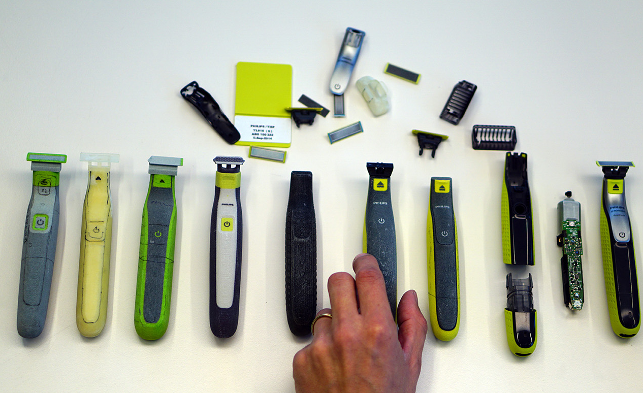
A line-up of OneBlade prototypes from initial volume models on the left through to the final product
The product would be located on the same shelf as manual blades but would have a more expensive price tag of Euro 40 (£34.99). Also, it’s the credibility of the product too – if it’s stated on the packaging that One Blade can cut through a full week of beard growth in one stroke consumers will think it’s pure marketing and difficult to believe.
“We obviously wanted to target these young guys that are shaving less frequently and are not after a clean shaven face every day but the problem we were facing is that older guys who do want a clean-shaven face every day will also pick the product up and then be disappointed when they don’t get the results they were hoping for,” comments Andersson.
Philips then rebooted its marketing strategy in order to get it into the hands of the target users and so opted to sell it online first before making it available in retail stores.
It used online marketing and then relied on users who bought the product from the Philips website or an online store like Amazon to spread the word via reveiws, blogs and forums.
“With this product, trying is really believing and we wanted to get a bit of a community promoting it which is much more effective than us promoting it. We were definitely able to create a buzz around it,” says Benders.
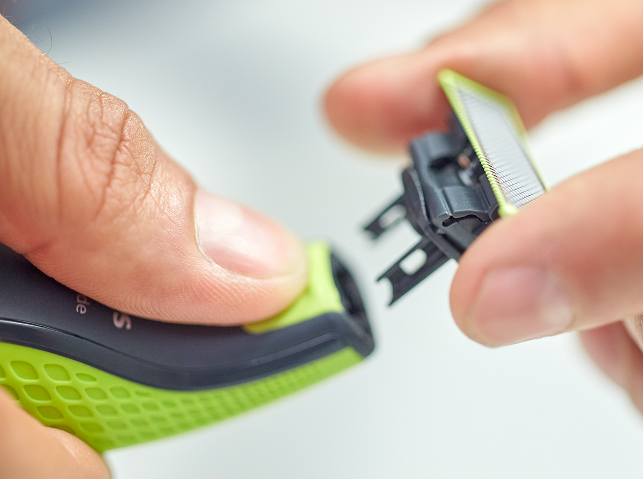
The blade can be easily ejected and will need to be replaced every four months
In fact, if you search the reviews of One Blade online they are very glowing to say the least: ‘It’s probably the best one I’ve used’, ‘Blown away’, ‘One stop man grooming shop’, ‘Saved me from razor burn’, ‘Best shaver money can buy’…
And it’s certainly exceeding Andersson’s expectations, “It has sold twice as much as we predicted it to do. We are just selling as many as we can produce at the moment and that is why we have not approached more markets yet.” A nice problem to have with Christmas approaching…
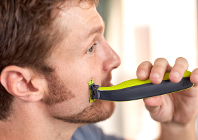
A shaver that’s not – Philips’ design for a new male grooming product
Default






